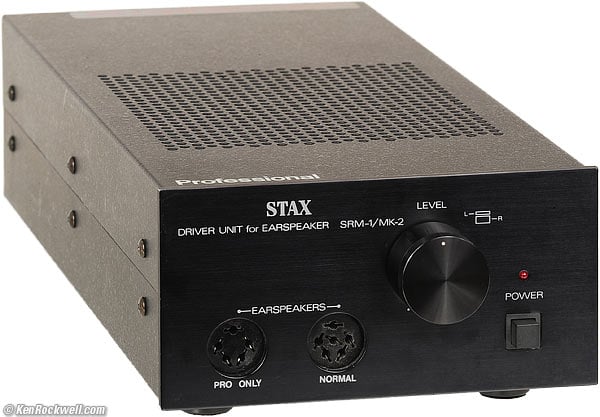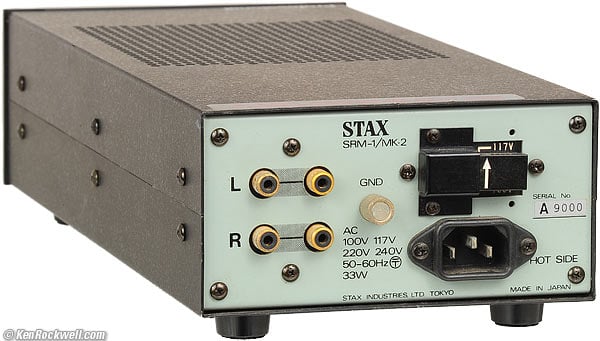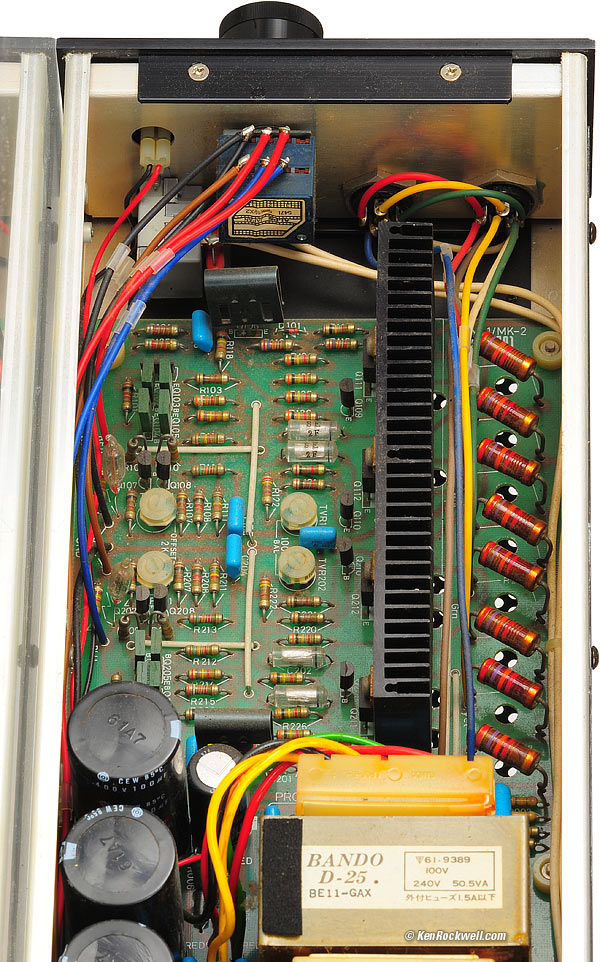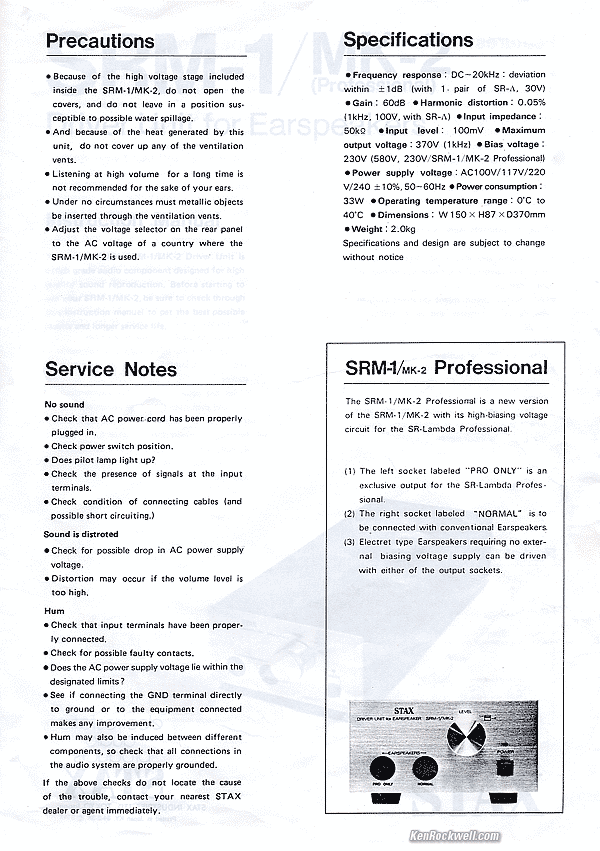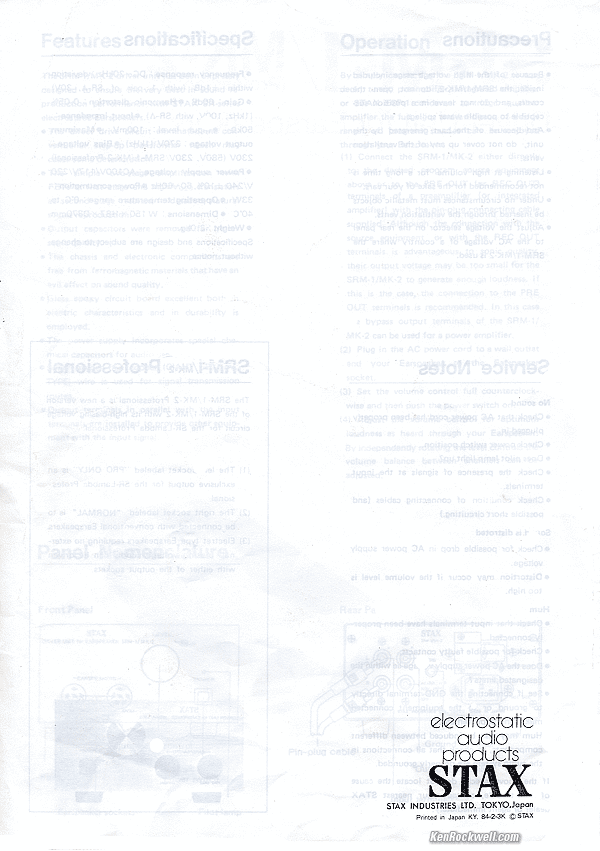Home Donate New Search Gallery Reviews How-To Books Links Workshops About Contact
Stax SRM-1/MK-2 Pro
(1982-1995)
© 2011 KenRockwell.com. All rights reserved.
Intro Specs Performance Compared Usage Recommendations
Stax SRM-1/MK-2 Professional Amplifier. enlarge. This free website's biggest source of support is when you use these links, especially this link directly to them at eBay, where they sell for about $500 (see How to Win at eBay). It helps me keep reviewing these oldies when you get yours through these links, thanks! Ken.
June 2012, July 2011 All Reviews Audio Reviews Stax Reviews
Electrostatic Headphones: How They Work, and Why They Sound Better.
Audio-Technica Beyer Sennheiser Sony Stax Ultrasone Velodyne Woo
Introduction top
Intro Specs Performance Compared Usage Recommendations
|
I buy only from these approved sources. I can't vouch for ads below. |
The Stax SRM-1/MK-2 Professional is a high-voltage amplifier and bias source for Stax' electrostatic headphones. It has both a Professional (580 V) and a Standard (230 V) output, so any Stax earspeaker ever made since 1959 works perfectly. (Stax' marketing people have always called their headphones "earspeakers.")
The SRM1-Mk-2 Professional is an FET-input, pure class-A, DC-coupled amplifier. It has no capacitors or transformers in the audio path. It's housed in a completely non-magnetic case to ensure no inadvertent magnetic coupling happens. It uses high-voltage bipolar transistors in its output stage.
It has enough output to deafen us with any of Stax' headphones, without any distortion.
It is fed from any device with 1/4" RCA jacks, or even directly from iPods and iPads with any 99¢ 3.5mm to RCA cord. If you do your iPod transfers correctly, this and a set of SR-Lambda Professionals sounds indescribably incredible from an iPod, if you'd just listen.
This SRM-1/Mk-2 Professional was Stax' top amplifier from 1982-1995. A few other amps came along during that time:
Versions and Historical Perspective
All versions of the SRM-1/MK-2 amps are the same, differing only in the bias supply fed to the diaphragm. They have come in both silver and black.
The audio amplifiers are the same, and in fact, regardless of bias voltage and pin count of any particular socket, the audio connected to each socket is actually wired directly to the same amplifier output. The audio sections of the two sockets are wired in parallel!
The only significant circuit differences among the versions are leads coming from one bias supply or another.
1979
The previous SRM-1 of 1979 had two standard 6-pin 230 V outputs.
1982
The SRM-1/MK-2 (not pro) of 1982 had two standard 6-pin 230 V outputs.
This "Professional" model came out at the same time as the new SR-Lambda Professional, with which it was often kitted. It changed one its outputs to 580 V bias, and used only a 5-pin socket to prevent standard headphones from being connected there by accident.
There were three internally slightly different versions of this SRM-1 Mark II Professional as evidenced by serial number prefixes of A, B or C, but this is an internal service note, not important to us users.
1985
Stax supplements their amplifier line with a new SRA-14S integrated amplifier.
1987
Stax supplements their amplifier line with the tube-type Stax SRM-T1.
1989
The SRM-1/MK-2 PP ("Pro-Pro") had both of its outputs supplied with the 580 V (5-pin) bias voltages.
1993
The new tube-type SRM-T1S debuts with the first SR-Omega.
1994
Stax introduces a new SR-Lambda Nova line to replaced the SR-Lambda line. Stax introduces a cacophony of new amplifiers, and this SRM-1/Mk-2 Professional is forgotten.
Rear, Stax SRM-1/MK-2 Professional Amplifier. enlarge.
Specifications top
Intro Specs Performance Compared Usage Recommendations
Name
Stax SRM-1/MK-2 is how its name is printed on the front and back of the amplifier, but be careful to look for the PROFESSIONAL printed on the top cover, or one jack marked PRO ONLY and the other marked NORMAL.
Others will write is as SRM-1 Mark II, SRM1-MK2, or other ways.
The SRM-1/MK-2 (not professional) has two standard (230 V bias) outputs, while this Professional version has one standard and one professional (580 V bias) output.
Inputs
There is one loop-through line-level input.
Rated 100 mV, 50 k Ohm.
Loop-through means they are wired together; you can insert this in between any two other components, and even if it's turned-off, the signal goes through.
Gain
60 dB (1,000x).
In other words, a 100 mV input can produce a 100 V output at maximum gain.
Frequency Response
Rated DC - 20 kHz, ±1 dB, at 30 V with one pair of SR-Lambda.
Distortion
Rated 0.01% THD at 1 kHz.
Rated 0.05% THD at 100 V at 1 kHz while driving an SR-Lambda.
Internal Wiring
Super oxygen-free copper with giant crystals.
Outputs
The two headphone audio (plate) outputs are connected in parallel.
Rated 370 V RMS maximum output at 1 kHz.
The bias voltage of the "normal" socket is standard 230 V, and the Professional outlet has a 580 V bias voltage.
Size
Rated 5.9 x 3.4 x 14.2 inches, WHD.
Rated 150 x 87 x 370 millimeters, WHD.
Weight
Rated 2,000 g. (70.5 oz. or 4.41 pounds).
Line Voltage and Power
Voltage: Rear-panel selectable 100 V, 117 V, 220 V or 240 V.
Frequency: 50 - 60 Hz.
Power Consumption: Rated 33 Watts.
Ambient Operating Temperature
0 ~ 40 º C (32 ~ 104ºF).
Price
1984: $1,700, corrected for inflation in 2011, including Stax SR-Lambda Professional headphones ($799 in 1984 dollars).
1990: $2,000, corrected for inflation in 2011, including Stax SR-Lambda Professional headphones ($1,199 in 1990 dollars).
2011: about $500 used at this link to them at eBay, amplifier only. (see How to Win at eBay).
Performance top
Intro Specs Performance Compared Usage Recommendations
Overall
See also Electrostatic Headphones: How They Work, and Why They Sound Better.
The Stax SRM-1/MK-2 Professional is a superb amplifier for any Stax Headphones.
Sound
It sounds great, without any noise or distortion even at deafening levels.
Gain
The gain structure is perfect: most of the time, I have the gain control set to the 12 o'clock position.
Left and right channels are friction coupled in one knob. To shift the channel balance, just hold both and turn each part of the knob in different directions.
Unlike the SRA amplifiers, there is no extra Intermediate Stage Amplifier. There is just the right amount of gain: not too much, and not too little, so if you need too much gain to overamplify very quiet passages, you might need more amplification. I've never wanted any more.
Noise
As far as I can hear, it's silent, so long as you have it installed correctly to avoid hum or buzz.
Hum
As it's all very high impedance, you must be attentive to your power and grounding scheme, or just like classic tube preamps, you'll pick up hum.
This amp was delivered to me with an ungrounded "cheater" cord, and had some hum in the final output of the amp unless I touched it, using my body as a ground.
As soon as I used a proper grounded HP-type power cord, the hum went away.
If running from an iPod, run the iPod on its battery. If you leave the iPod plugged into your computer, you can set up a ground loop. This can get complicated: I used to design grounding systems for a living.
Ideally, you want to have the grounds connect at only one point in the system, a "star" ground. Ground loops are when you ground the amp at the power cord, you have your source grounded, and then bring the ground across the two with an audio cable. You just created a big triangle, and any magnetic field will induce voltages into this big triangle, and thus into your audio.
Ergonomics
Everything should be this simple: one power switch that I leave on eternally, and one gain (volume) control.
The gain control feels great: it's slick, smooth and undamped. It flicks up and down with ease.
It's easy to find and grab the knob and turn it from any angle, even in the pitch dark, for fast and precise adjustment. I love real volume control knobs; you can take digital up/down buttons and shaft encoders and put them in the doo-dah (garbage) can.
Stax uses a premium semi-sealed Alps 50 k Ohm potentiometer, and it's as smooth as the glassy feel that Penny + Giles used to advertise for their professional audio controls.
The power LED flickers at 60 Hz, not DC.
Circuitry
Guts, Stax SRM-1/MK-2 Professional Integrated Amplifier. enlarge.
WARNING: Deadly voltages present even when unplugged. Don't do this.
The SRM-1/Mk II is very well made. I'd hope I could make something this well if I was building it myself. The wiring is neat and clean, and they use fancy super oxygen-free copper wire with giant crystals that I wouldn't know where to buy (I build my own gear with military teflon-insulated silver wire).
The components are first-rate: even the decoupling capacitors are audiophile-grade polystyrene or polypropylene.
Pure DC coupled: no transformers and no capacitors in the audio path.
Completely non-magnetic chassis to prevent any unintended signal interactions.
It runs pure class-A, with FETs in the first amplification stage, and bipolar transistors in the output stage.
Circuit boards are glass epoxy, and even the power supply capacitors are all of special chemistry for audio use.
Heat
As a pure class-A device, everything runs as hot, or hotter, at idle as it does at full output.
This amplifier is supposed to get hot, even sitting idle.
The power output transistors are on a heat sink, so their heat is well distributed. There aren't hot spots, as there are on the SRA-12S; the entire SRM-1/MK-2 gets hot!
Mechanics
The SRM-1 Mark II Professional is built internally more like a piece of military or industrial hardware than almost anything from what passes for professional audio gear today.
The amp is built on a heavy inner aluminum chassis with nonmagnetic top and bottom covers, and a solid aluminum front panel.
Stax deliberately made everything nonmagnetic to eliminate unintended audio interactions.
Stainless-steel machine screws hold the nonmetallic metal covers in place by screwing into solid metal inserts. Stax never got lazy and tried to use self-tapping bung screws; they took this seriously.
Compared top
Intro Specs Performance Compared Usage Recommendations
I doubt newer amplifiers work or sound any differently, or even as good. Stax spared no expense with this amplifier.
I don't believe that amplifiers make much difference, while transducers make a huge difference. If you can score one of these, you're set, because this particular Professional version has a socket for each type of headphone ever made by Stax. Older (non-pro, 230 V only) or newer ("PP," 580V only) versions lose the ability to work optimally (or at all) with newer or older earspeakers.
This SRM-1/MK-2 pro is silent when used properly, quieter than the SRA-12S; the SRM-1/II pro has no hum or noise.
The reason to go for one of Stax' much harder to find integrated preamplifiers like the SRA-12S (or a newer amplifier) is if you want more inputs or controls; if all you want is audio perfection, you've got it in the SRM-1/MK-2 Professional.
Usage top
Intro Specs Performance Compared Usage Recommendations
DANGER: Feedback
If a headphone's cord is resting on your body, and if you pull a plug out of another piece of equipment and touch the tip, at volume settings above about 12 o'clock you may get positive feedback that results in a 120 dB screetch at about 7 kHz, enough to deafen you temporalily, or cause permanent hearing loss.
The electrical signal can couple through your body to the cord and back into the amplifier, and at high gain settings, cause the whole system to oscillate at full output.
The inputs are very high impedance (50k Ω) and, if not connected to a live signal, can start picking things up on their own.
Don't ever unplug anything with the volume control set to anything other then zero.
ALWAYS turn down the volume before changing any connections!
Worse, with an iPad in my hand, plugged directly into the SRM 1 MK2 and with the Stax Lambda Pro cable lying across me, reaching for the amp's gain control and setting it high also nearly deafened me with feedback. I suspect 10 kHz capacitively coupled from the headphone's cable back through my body and into the iPad, so don't touch the amplifier if you have an iPad or iPod in your other hand. iPads were still 30 years away when this amplifier was designed.
Heat
This amplifier is a class-A power amplifier, and it gets HOT.
If you cover any of the top or bottom convective cooling holes, it probably will catch fire.
Never put anything on top of this amplifier. Not only are you likely to damage the amplifier, you may burn whatever you put on top.
Proper airflow is critical. No fan is used for noise reasons. Air flows naturally with convection from bottom to top, so you must leave all the slots and holes free.
Safety
Watch for High Voltage when plugging and unplugging headphones: even when off, it's easy to touch the connector pins and potentially (hee hee) get a shock.
Charge Time
This system uses static electricity, meaning non-moving (static) electric charges.
The static charge, AKA polarizing voltage, is supposed to take a few minutes to spread around the diaphragm. If the charge was free to move at will, it would move under the forces that are supposed to move the diaphragm when subjected to voltage fields from the plates. If the charge was free to move (not static), electrostatic headphones and speakers wouldn't work.
Therefore, it may take time for the charge to spread out evenly across the diaphragm.
As the charge spreads, it is normal for the audio to increase slightly in level for the first few minutes. It's also normal for each channel to come up at slightly different rates, meaning it is expected that for the first few seconds the channels may seem unbalanced.
Some people prefer to leave their headphones energized all the time, however I'd be careful, as the high voltages work like an air cleaner sucking-in all the dust into the headphones which I don't think are sealed, so make your own choice here. Some people say, and I wouldn't disagree with them, that electrostatic systems sound better if they're left plugged in for at least a day.
Users Manual
Click any page to enlarge.
Recommendations top
Intro Specs Performance Compared Usage Recommendations
The only place to find these limited-production amplifiers is here at eBay, where they usually sell for about $500 if you know How to Win at eBay.
As it's convection cooled and 30 years old, you may want to have your certified technician suck out any dust bunnies that have accumulated inside.
If you've found my efforts in documenting this classic equipment helpful, this free website's biggest source of support is when you use these links, especially this link directly to them at eBay, where they sell for about $500 (see How to Win at eBay). It helps me keep reviewing these oldies when you get yours through these links, thanks! Ken.
Help me help you top
I support my growing family through this website, as crazy as it might seem.
The biggest help is when you use any of these links to Adorama, Amazon, eBay, Ritz, Calumet and J&R and when you get anything. It costs you nothing, and is this site's, and thus my family's, biggest source of support. eBay is always a gamble, but all the other places always have the best prices and service, which is why I've used them since before this website existed. I recommend them all personally.
If you find this page as helpful as a book you might have had to buy or a workshop you may have had to take, feel free to help me continue helping everyone.
If you've gotten your gear through one of my links or helped otherwise, you're family. It's great people like you who allow me to keep adding to this site full-time. Thanks!
If you haven't helped yet, please do, and consider helping me with a gift of $5.00.
As this page is copyrighted and formally registered, it is unlawful to make copies, especially in the form of printouts for personal use. If you wish to make a printout for personal use, you are granted one-time permission only if you PayPal me $5.00 per printout or part thereof. Thank you!
Thanks for reading!
Mr. & Mrs. Ken Rockwell, Ryan and Katie.
Home Donate New Search Gallery Reviews How-To Books Links Workshops About Contact
